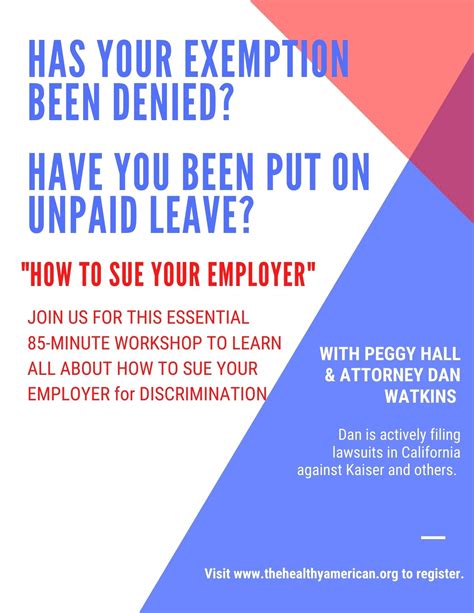How Do I Sue My Employer For Wrongful Termination
Ronan Farrow
Apr 04, 2025 · 4 min read

Table of Contents
How Do I Sue My Employer for Wrongful Termination? A Guide to Your Legal Options
Being terminated from your job can be a devastating experience, especially when you believe it was done unfairly. Wrongful termination is a serious legal matter, and understanding your options is crucial. This guide will walk you through the process of suing your employer for wrongful termination, providing a clear understanding of the steps involved and the potential outcomes. Note: This information is for general guidance only and is not a substitute for legal advice from a qualified attorney. Each case is unique, and the specific laws and procedures will vary based on your location and the specifics of your situation.
Understanding Wrongful Termination
Wrongful termination occurs when an employer fires an employee for an illegal or unjust reason. Unlike many countries, the United States generally operates under an "at-will employment" system. This means employers can typically terminate employees for any reason that isn't illegal or violates a contract. However, there are exceptions to this rule. Common grounds for wrongful termination claims include:
Types of Wrongful Termination Claims
-
Breach of Contract: If you had a written or implied employment contract promising specific terms, such as a certain duration of employment or a specific reason for termination, and the employer violated those terms, you might have grounds for a claim.
-
Discrimination: Federal and state laws prohibit discrimination based on protected characteristics such as race, religion, gender, age, national origin, disability, or pregnancy. If you were fired because of your membership in a protected class, you might have a strong case.
-
Retaliation: If you were terminated for whistleblowing, reporting illegal activity, filing a worker's compensation claim, or exercising other legally protected rights, you may have a retaliation claim.
-
Wrongful Discharge in Violation of Public Policy: This occurs when your termination violates a clear mandate of public policy, such as refusing to participate in an illegal activity.
Steps to Take After Wrongful Termination
1. Gather Evidence: Document everything. This includes your employment contract, performance reviews, emails, messages, and any other communication related to your employment and termination. Collect witness testimonies if applicable.
2. Consult with an Employment Lawyer: This is crucial. An experienced employment attorney can assess your case, advise you on your legal options, and guide you through the process. They will help you determine if you have a viable claim and the best strategy for pursuing it.
3. File a Claim (if applicable): Depending on the type of claim and your location, you may need to file a charge of discrimination with the Equal Employment Opportunity Commission (EEOC) or a similar state agency before you can file a lawsuit. This step is often a prerequisite to pursuing legal action.
4. Consider Mediation or Arbitration: In some cases, mediation or arbitration might be an alternative to a full-blown lawsuit. This can be a less expensive and time-consuming way to resolve the dispute.
5. File a Lawsuit (if necessary): If you and your employer can't reach a settlement, your attorney will help you file a lawsuit in the appropriate court. This involves preparing and filing the necessary paperwork, participating in discovery (the exchange of information between both sides), and potentially going to trial.
What to Expect During a Lawsuit
The legal process can be lengthy and complex. Be prepared for:
-
Discovery: This phase involves both sides exchanging documents and information. You may be deposed (give a sworn testimony).
-
Settlement Negotiations: Many cases settle before trial. Your attorney will negotiate with the employer's attorney to try and reach a fair settlement.
-
Trial: If a settlement isn't reached, your case will go to trial. The outcome will depend on the evidence presented and the judge or jury's decision.
Potential Outcomes
A successful wrongful termination lawsuit could result in:
- Back pay: Compensation for lost wages and benefits.
- Front pay: Compensation for future lost wages.
- Reinstatement: Getting your job back.
- Compensatory damages: Compensation for emotional distress, pain, and suffering.
- Punitive damages: Punishment for the employer's malicious or reckless conduct (in some cases).
Suing your employer for wrongful termination is a significant undertaking. Seeking legal counsel is paramount. A skilled attorney can help you navigate the complexities of the legal process, protect your rights, and maximize your chances of a favorable outcome. Remember to meticulously document everything and keep open communication with your attorney throughout the process.
Featured Posts
Also read the following articles
| Article Title | Date |
|---|---|
| How Do Frame Jeans Fit | Apr 04, 2025 |
| How Does Welvie Make Money | Apr 04, 2025 |
| How Do You Cut Silestone | Apr 04, 2025 |
| How Do I Know When My Caspa Application Is Verified | Apr 04, 2025 |
| How Hard Is It To Move A Thermostat | Apr 04, 2025 |
Latest Posts
-
How Is A Water Bill Calculated
Apr 04, 2025
-
How Is A Squeegee Used In The Silkscreen Process
Apr 04, 2025
-
How Is A Night Guard Supposed To Fit
Apr 04, 2025
-
How Is A Lateral Scored In Fantasy Football
Apr 04, 2025
-
How Is A Crown Replaced
Apr 04, 2025
Thank you for visiting our website which covers about How Do I Sue My Employer For Wrongful Termination . We hope the information provided has been useful to you. Feel free to contact us if you have any questions or need further assistance. See you next time and don't miss to bookmark.
